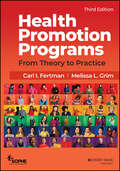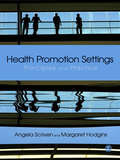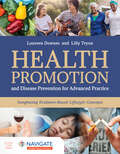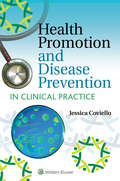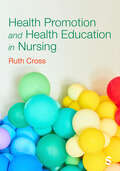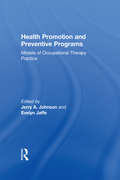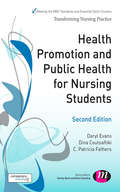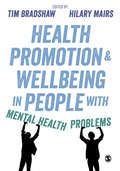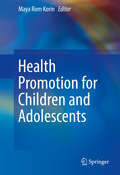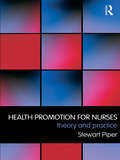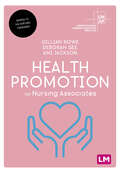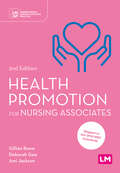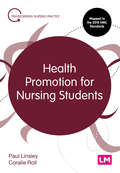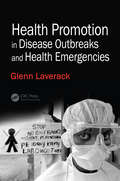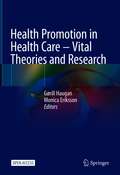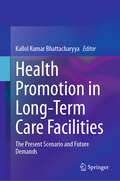- Table View
- List View
Health Promotion Programs: From Theory to Practice (Jossey-Bass Public Health)
by (SOPHE) Society for Public Health EducationAn incisive, up-to-date, and comprehensive treatment of effective health promotion programsIn the newly revised Third Edition of Health Promotion Programs: From Theory to Practice, health and behavior experts Drs. Carl I. Fertman and Melissa Grim deliver a robust exploration of the history and rapid evolution of health promotion programs over the last three decades. The authors describe knowledge advances in health and behavior that have impacted the planning, support, and implementation of health promotion programs. With thoroughly updated content, statistics, data, figures, and tables, the book discusses new resources, programs, and initiatives begun since the publication of the Second Edition in 2016. "Key Terms" and "For Practice and Discussion Questions" have been revised, and the authors promote the use of health theory by providing the reader with suggestions, models, boxes, and templates. A renewed focus on health equity and social justice permeates much of the book, and two significant health promotion and education events- the HESPA ll study and Healthy People 2030- are discussed at length. Readers will also find: A thorough introduction to health promotion programs, including the historical context of health promotion, settings and stakeholders for health promotion programs, advisory boards, and technology disruption and opportunities for health promotion. Comprehensive explorations of health equity and social justice, including dicussions of vulnerable and underserved population groups, racial and ethnic disparities in health and minority group engagement. Practical discussions of theory in health promotion programs, including foundational theories and health promotion program planning models. In-depth examinations of health promotion program planning, including needs assessments and program support. Perfect for undergraduate and graduate students studying public health, health administration, nursing, and medical research, Health Promotion Programs: From Theory to Practice is also ideal for medical students seeking a one-stop resource on foundational concepts and cutting-edge developments in health promotion programs.
Health Promotion Programs: From Theory to Practice (Jossey-Bass Public Health)
by Carl I. Fertman Diane D. Allensworth Society for Public Health Education (SOPHE)Comprehensive coverage, real-world issues, and a focus on the practical aspects of health promotion Health Promotion Programs combines theory and practice to deliver a comprehensive introduction to the planning, implementation, and evaluation of health promotion programs. Presenting an overview of best practices from schools, health care organizations, workplaces, and communities, this book offers clear, practical guidance with an emphasis on hands-on learning. This new second edition has been updated to include discussion on today's important issues, including health equity, the Affordable Care Act, big data, E-health, funding, legislation, financing, and more. New coverage includes programs for underserved priority populations at a geographically-diverse variety of sites, and new practice and discussion questions promote engagement on highly-relevant topics. Public health is a critical aspect of any society, and health promotion programs play an important role. This book provides clear instruction, practical guidance, and multiple avenues to deeper investigation. Plan health promotion programs from the basis of health theory Gain in-depth insight on new issues and challenges in the field Apply what you're learning with hands-on activities Access digital learning aids and helpful templates, models, and suggestions Designed to promote engagement and emphasize action, this book stresses the importance of doing as a vital part of learning—yet each step of the process is directly traceable to health theory, which provides a firm foundation to support a robust health promotion program. Health Promotion Programs is the essential introductory text for practical, real-world understanding.
Health Promotion Settings: Principles and Practice
by Ms Margaret Hodgins Angela ScrivenHealth Promotion Settings combines the theoretical discourse of the settings approach, covering a wide range of fundamental principles, concepts and policy issues, with real life examples of settings, including workplaces, schools, neighbourhood, cities and prisons. Frameworks and processes that are actively shaping health promotion in settings in the 21st Century are documented and the ideas and research covered will provide a vital set of indicators for those who promote health in settings. Combining theory with practical examples and case studies, the authors show how a settings approach can work in practice, drawing on a range of local, national and international initiatives and coordinated projects. Health Promotion Settings provides a rich source of ideas and case examples which highlight the challenges for promoting health in a range of contexts. Special attention is given to the workplace as both a priority area for health promotion and a key determinant of health. Written by a highly experienced team of health promotion and public health professionals, academics and researchers, this book is essential reading for both students and practitioners working towards the improvement of health using a settings approach. Online Resources are provided.
Health Promotion and Disease Prevention for Advanced Practice: Integrating Evidence-Based Lifestyle Concepts
by Loureen Downes Lilly TryonHealth Promotion and Disease Prevention for Advanced Practice: Integrating Evidence-Based Lifestyle Concepts is a unique new resource that is not afraid to address lifestyle concepts that can change the trajectory of healthcare in the United States and globally. It provides practical, evidence-based approaches to reduce the pandemic of preventable lifestyle-related chronic diseases such as heart disease, hypertension, some strokes, type 2 diabetes, obesity, and multiple types of cancer. It provides nurse practitioners and physician assistants with the lifestyle management tools needed to contribute to a higher level of care to promote health and prevent disease. The authors take a deep dive into the literature regarding lifestyle concepts and practical management of lifestyle-related chronic diseases. They discuss the root causes of diseases and approaches for patient-centered care, strategies for health promotion reimbursement, and trending telehealth delivery of health care.
Health Promotion and Disease Prevention in Clinical Practice
by Jessica S. CovielloThe Third Edition of Health Promotion and Disease Prevention in Clinical Practice reflects a clinically-focused, team-based approach to health promotion conversations. This practical reference incorporates the latest guidelines from major organizations, including the U.S. Preventive Services Task Force, and offers a complete overview of how to help patients adopt healthy behaviors and deliver recommended screening tests and immunizations. Packed with realistic strategies throughout, it offers expert guidance on counseling patients about exercise, nutrition, tobacco use, substance use, sexually transmitted infections, depression, and more.
Health Promotion and Health Education in Nursing
by Ruth CrossHealth promotion is a core nursing topic and for the past decade, as a nurse, you will be spending more time and energy in the community, doing preventative work and helping to rebalance services away from hospitals. You are expected to ‘Make Every Contact Count’ and look for opportunities to encourage healthier behaviours and lifestyles each time you engage with an individual. The recent Coronavirus epidemic has brought public health and health promotion activities even more sharply into the spotlight and this has made a huge impact on the work you do. This book focuses on health education – this is the core health promotion work that you will do on a daily basis and it is ideal for those studying at Masters level. It takes an international approach, with Ruth Cross being extremely experienced with a proven track record in the health promotion community. This book includes: Explanations of the theory and context of health promotion and health education International content from people in the field including Norway, Australia and Ghana ′Tutorial Triggers′, ′Points to Ponder′ and ′Time to Reflect′ features, encouraging you to apply the chapter content to your practice Real-life examples across the lifespan and in a range of different settings
Health Promotion and Health Education in Nursing
by Ruth CrossHealth promotion is a core nursing topic and for the past decade, as a nurse, you will be spending more time and energy in the community, doing preventative work and helping to rebalance services away from hospitals. You are expected to ‘Make Every Contact Count’ and look for opportunities to encourage healthier behaviours and lifestyles each time you engage with an individual. The recent Coronavirus epidemic has brought public health and health promotion activities even more sharply into the spotlight and this has made a huge impact on the work you do. This book focuses on health education – this is the core health promotion work that you will do on a daily basis and it is ideal for those studying at Masters level. It takes an international approach, with Ruth Cross being extremely experienced with a proven track record in the health promotion community. This book includes: Explanations of the theory and context of health promotion and health education International content from people in the field including Norway, Australia and Ghana ′Tutorial Triggers′, ′Points to Ponder′ and ′Time to Reflect′ features, encouraging you to apply the chapter content to your practice Real-life examples across the lifespan and in a range of different settings
Health Promotion and Preventive Programs: Models of Occupational Therapy Practice
by Jerry A Johnson Evelyn JaffeFor occupational therapists who want to incorporate health promotion or prevention into their practices, here is a thought-provoking new volume. Health Promotion and Preventive Programs highlights existing models of occupational therapy practice, targeting populations ranging from infants to the elderly, that incorporate principles of prevention and health promotion into traditional health care practice arenas.This important new book describes a variety of occupational therapy services, each of which uses principles of primary, secondary, or tertiary prevention principles, including a health education program for parents of well babies and toddlers, a community outreach program for preschool children who are at risk for emotional problems, a community support group formed by adults who have been hospitalized for psychiatric illnesses, a program designed to prevent industrial accidents through on-the-job training, and a home safety program for the elderly.The effective case study approach will allow occupational therapists to learn about and compare various models of practice, and includes elements necessary for development, organization, and design of health promotion and disease prevention programs. Together the chapters provide theoretical concepts of health promotion and injury prevention and offer a framework by which professionals can analyze material, determine whether or not programs can be appropriately replicated, or design new and original occupational therapy programs having a focus on health promotion and/or disease prevention.
Health Promotion and Public Health for Nursing Students
by Dina Coutsaftiki Daryl Evans C. Patricia FathersThe health service is changing to emphasise the need for public involvement and empowerment in their own health. Student nurses need preparation for practice which brings health promotion into the forefront of nursing care. Written in clear language and in a simple to use format, this book provides a practical guide to what health promotion is and how it interacts with public health. It focuses on the real world and explains carefully how health promotion can be implemented in straightforward terms, while drawing on the main theories, models and evidence that inform practice. The book covers the essential topics like lifestyle changes, health screening and teaching patients enabling students to become health promoting nurses of the future. Key features Case studies and scenarios makes theory easy to apply to nursing practice Plenty of activities help build critical thinking and independent learning skills Applicable to the whole pre-registration nursing programme, all levels and fields including child and adolescent perspectives and health promotion for mental health
Health Promotion and Public Health for Nursing Students (Transforming Nursing Practice)
by Dina Coutsaftiki Daryl Evans C. Patricia Fathers<P>Preventing illness and improving the general health of the population is a vital priority for the health service with nurses expected to play a central role. Written using clear language this book explains what health promotion is and how it interacts with public health. It shows how health promotion can be implemented while drawing on the main theories, models and evidence that inform practice. The book covers the essential topics like lifestyle changes, health screening and patient education giving you the necessary tools and confidence to integrate health promotion into your day to day nursing practice. <P>Transforming Nursing Practice is a series tailor made for pre-registration student nurses. Each book in the series is: <P> Affordable <P> Mapped to the NMC Standards and Essential Skills Clusters <P> Focused on applying theory to practice <P> Full of active learning features
Health Promotion and Wellbeing in People with Mental Health Problems
by Hilary Mairs Tim BradshawThis practical guide helps nursing students and other healthcare professionals promote and improve the health and wellbeing of those with mental health problems by looking closely at the disparities that people with mental health problems face in relation to their physical health. It includes: • Evidence-based techniques such as motivational interviewing and promoting physical activity. • MCQs at the start of each chapter for readers to test their knowledge. • Reflection points, activities and case studies to link theory to practice. • Summaries of key messages to take away. This is essential reading for all nursing students and healthcare professionals.
Health Promotion and Wellbeing in People with Mental Health Problems
by Hilary Mairs Tim BradshawThis practical guide helps nursing students and other healthcare professionals promote and improve the health and wellbeing of those with mental health problems by looking closely at the disparities that people with mental health problems face in relation to their physical health. It includes: • Evidence-based techniques such as motivational interviewing and promoting physical activity. • MCQs at the start of each chapter for readers to test their knowledge. • Reflection points, activities and case studies to link theory to practice. • Summaries of key messages to take away. This is essential reading for all nursing students and healthcare professionals.
Health Promotion for Children and Adolescents
by Maya Rom KorinThis timely volume surveys the broad spectrum of interventions used in health promotion, and shows how they may be tailored to the developmental needs of children and adolescents. Its multilevel lifespan approach reflects concepts of public health as inclusive, empowering, and aimed at long- and short-term well-being. Coverage grounds readers in theoretical and ecological perspectives, while special sections spotlight key issues in social and behavioral wellness, dietary health, and children and teens in the health care system. And in keeping with best practices in the field, the book emphasizes collaboration with stakeholders, especially with the young clients themselves. Among the topics covered: Child mental health: recent developments with respect to risk, resilience, and interventions Health-related concerns among children and adolescents with ADD/ADHD Preventing risky sexual behavior in adolescents Violence affecting youth: pervasive and preventable Childhood and adolescent obesity Well-being of children in the foster care system "Health" "Promotion" "for" "Children" "and" "Adolescents" is a necessary text for graduate or advanced undergraduate courses in public health, education, medicine, psychology, health education, social work, curriculum, nutrition, and public affairs. It is also important reading for public health professionals; researchers in child health, health education, and child psychology; policymakers in education and public health; and teachers.
Health Promotion for Nurses: Theory and Practice
by Stewart PiperHealth promotion is an increasingly high profile aspect of a nurse’s role – both in line with health policy and as nursing has shifted from a disease model to a health model. This textbook explores how and why health promotion works in nursing, developing a new framework for understanding the nurse’s role and promoting evidence-based practice. Drawing on empirical research and discussing existing theories of health promotion and of nursing, Stewart Piper identifies three principal approaches: The Nurse as Behaviour Change Agent The Nurse as Strategic Practitioner The Nurse as Empowerment Facilitator The book describes the aims, processes, impact and outcomes of health promotion interventions in nursing for each of these models and identifies criteria for evaluating the associated nursing interventions – enabling clinical judgements about effective practice. Evidence-based examples demonstrate the relationship between health promotion theory and pragmatic applications for nursing throughout. Each chapter includes an introduction, learning outcomes and exercises, making this an essential book for all nursing students studying health promotion.
Health Promotion for Nursing Associates (Understanding Nursing Associate Practice)
by Gillian Rowe Deborah Gee Ami JacksonPromoting health and preventing ill health is central to your role as a nursing associate. Written in clear language and full of examples from practice, this book introduces all aspects of health promotion that you need to know. Covering essential topics such as health inequality and mental health promotion, the book develops your knowledge and skills in health promotion at the individual, community and population level. Key features o Fully mapped to the 2018 NMC standards of proficiency for nursing associates o Case studies, activities and insights from real TNAs illustrate health promotion in different settings across all fields of nursing o Focussed specifically on the requirements of the nursing associate role, helping you to develop into a confident professional practitioner
Health Promotion for Nursing Associates (Understanding Nursing Associate Practice)
by Gillian Rowe Deborah Gee Ami JacksonPromoting health and preventing ill health is central to your role as a nursing associate. Written in clear language and full of examples from practice, this book introduces all aspects of health promotion that you need to know. Covering essential topics such as health inequality and mental health promotion, the book develops your knowledge and skills in health promotion at the individual, community and population level. Key features o Fully mapped to the 2018 NMC standards of proficiency for nursing associates o Case studies, activities and insights from real TNAs illustrate health promotion in different settings across all fields of nursing o Focussed specifically on the requirements of the nursing associate role, helping you to develop into a confident professional practitioner
Health Promotion for Nursing Associates (Understanding Nursing Associate Practice)
by Gillian Rowe Deborah Gee Ami JacksonPromoting health and preventing ill health is central to your role as a nursing associate. Written in clear language and full of examples from practice, this book introduces all the aspects of health promotion that you need to know. Covering essential topics such as health inequalities, mental health promotion and making sense of demographic data, and with a new expanded look at culture and communication, supporting mental health for Children and Young People and the impact of socio-economic inequalities on access, this book develops your knowledge and skills in health promotion at the individual, community and population level. Key features: • Fully mapped to the 2018 NMC standards of proficiency for nursing associates • Case studies, activities and new insights from real TNAs illustrate health promotion in different settings across all fields of nursing • Written specifically to reflect the unique experiences, challenges and requirements of the nursing associate role, helping you to develop into a confidence and professional practitioner ABOUT THE SERIES: The Understanding Nursing Associate Practice series (UNAP) is a new collection of books uniquely designed to support trainee nursing associates throughout their training and into a professional career.
Health Promotion for Nursing Associates (Understanding Nursing Associate Practice)
by Gillian Rowe Deborah Gee Ami JacksonPromoting health and preventing ill health is central to your role as a nursing associate. Written in clear language and full of examples from practice, this book introduces all the aspects of health promotion that you need to know. Covering essential topics such as health inequalities, mental health promotion and making sense of demographic data, and with a new expanded look at culture and communication, supporting mental health for Children and Young People and the impact of socio-economic inequalities on access, this book develops your knowledge and skills in health promotion at the individual, community and population level. Key features: • Fully mapped to the 2018 NMC standards of proficiency for nursing associates • Case studies, activities and new insights from real TNAs illustrate health promotion in different settings across all fields of nursing • Written specifically to reflect the unique experiences, challenges and requirements of the nursing associate role, helping you to develop into a confidence and professional practitioner ABOUT THE SERIES: The Understanding Nursing Associate Practice series (UNAP) is a new collection of books uniquely designed to support trainee nursing associates throughout their training and into a professional career.
Health Promotion for Nursing Students (Transforming Nursing Practice Series)
by Paul Linsley Coralie RollPromoting and maintaining good mental, physical and behavioural health of individuals, communities and populations is a key role of the registered nurse. Understanding how to incorporate health promotion into clinical practice will be an important part of a nurse&’s undergraduate studies and something they will take with them into professional life. This book will help students to understand the underlying theory behind health promotion and the different considerations for working with individuals, families and diverse communities. It will also demonstrate the practical skills needed in order to promote health and well-being effectively upon entering the practice environment. Key features: Mapped to the new NMC standards of proficiency for registered nurses (2018) Case studies, activities and other learning features help students translate the theory to practice Focus on practical skills to help guide daily practice
Health Promotion for Nursing Students (Transforming Nursing Practice Series)
by Paul Linsley Coralie RollPromoting and maintaining good mental, physical and behavioural health of individuals, communities and populations is a key role of the registered nurse. Understanding how to incorporate health promotion into clinical practice will be an important part of a nurse&’s undergraduate studies and something they will take with them into professional life. This book will help students to understand the underlying theory behind health promotion and the different considerations for working with individuals, families and diverse communities. It will also demonstrate the practical skills needed in order to promote health and well-being effectively upon entering the practice environment. Key features: Mapped to the new NMC standards of proficiency for registered nurses (2018) Case studies, activities and other learning features help students translate the theory to practice Focus on practical skills to help guide daily practice
Health Promotion for Nursing Students (Transforming Nursing Practice Series)
by Paul Linsley Coralie RollPromoting health and preventing ill health form a central part of nursing study and a daily part of your future role as a nurse. In straightforward language, this book introduces the theory and concepts of health promotion and how to incorporate them into your clinical practice. Focused on the practical skills you need, it develops your confidence in promoting health and wellbeing effectively among individuals, families and diverse communities, as well as in yourself. Key features: Mapped to the 2018 NMC Standards Fully updated including a new chapter on public mental health Case studies and activities illustrate how to build health promotion into your daily practice
Health Promotion for Nursing Students (Transforming Nursing Practice Series)
by Paul Linsley Coralie RollPromoting health and preventing ill health form a central part of nursing study and a daily part of your future role as a nurse. In straightforward language, this book introduces the theory and concepts of health promotion and how to incorporate them into your clinical practice. Focused on the practical skills you need, it develops your confidence in promoting health and wellbeing effectively among individuals, families and diverse communities, as well as in yourself. Key features: Mapped to the 2018 NMC Standards Fully updated including a new chapter on public mental health Case studies and activities illustrate how to build health promotion into your daily practice
Health Promotion in Disease Outbreaks and Health Emergencies
by Glenn LaverackThe book is exceptionally timely and will be of interest to many professionals, students and academics. I am not aware of any other book that covers this important topic. Glenn Laverack brings credibility and kudos having direct experience of health emergencies and seen as a leading academic thinker in health promotion. Dr James Woodall, Reader in Health Promotion, Leeds Beckett University Using specific examples to illustrate broader concepts, this text provides a solid introduction to health promotion in infectious disease outbreaks. Ella Watson-Stryker, Health Promotion Manager, Médecins Sans Frontières This book is timely given the current humanitarian and development scenarios in which health promoters and development communicators must work. There is a dire need for reference materials for practitioners which expand upon theoretical/scientific concepts and principles and provide practical, straightforward guidance to professionals working in the field. The increasing amount of public health emergencies, e.g. SARS, Ebola, Zika etc. require professionals to increase their preparedness to respond in outbreak or disaster situations and this book becomes a useful tool for needed action. Dr Erma Manoncourt, Vice-President of Membership and Co-Chair Global Working Group on the Social Determinants of Health, IUHPE, Paris, France. This is the first ever practical guide to the valuable role that health promotion can play in disease outbreaks and health emergencies. Over the past 20 years the number of disease outbreaks has increased alongside a significant role played out by international agencies involved in emergency responses. The book comprehensively covers the role that health promoters have in this new and exciting field of international work including data collection, communication, community capacity building and engagement and rumour management. Part 1 provides a detailed overview of the role of health promotion in disease outbreaks and health emergencies. Part 2 directly addresses the role of health promotion in two distinct types of disease outbreaks: person to person and vector borne disease transmission. Part 3 covers the role of health promotion in specialist areas of work in disease outbreaks and health emergencies. Health Promotion in Disease Outbreaks and Health Emergencies is essential reading for health promotion and public health students worldwide, as well as for UN agencies and international NGOs working in this emerging field.
Health Promotion in Health Care – Vital Theories and Research
by Monica Eriksson Gørill HauganThis open access textbook represents a vital contribution to global health education, offering insights into health promotion as part of patient care for bachelor’s and master’s students in health care (nurses, occupational therapists, physiotherapists, radiotherapists, social care workers etc.) as well as health care professionals, and providing an overview of the field of health science and health promotion for PhD students and researchers. Written by leading experts from seven countries in Europe, America, Africa and Asia, it first discusses the theory of health promotion and vital concepts. It then presents updated evidence-based health promotion approaches in different populations (people with chronic diseases, cancer, heart failure, dementia, mental disorders, long-term ICU patients, elderly individuals, families with newborn babies, palliative care patients) and examines different health promotion approaches integrated into primary care services. This edited scientific anthology provides much-needed knowledge, translating research into guidelines for practice. Today’s medical approaches are highly developed; however, patients are human beings with a wholeness of body-mind-spirit. As such, providing high-quality and effective health care requires a holistic physical-psychological-social-spiritual model of health care is required. A great number of patients, both in hospitals and in primary health care, suffer from the lack of a holistic oriented health approach: Their condition is treated, but they feel scared, helpless and lonely. Health promotion focuses on improving people’s health in spite of illnesses. Accordingly, health care that supports/promotes patients’ health by identifying their health resources will result in better patient outcomes: shorter hospital stays, less re-hospitalization, being better able to cope at home and improved well-being, which in turn lead to lower health-care costs. This scientific anthology is the first of its kind, in that it connects health promotion with the salutogenic theory of health throughout the chapters. the authors here expand the understanding of health promotion beyond health protection and disease prevention. The book focuses on describing and explaining salutogenesis as an umbrella concept, not only as the key concept of sense of coherence.
Health Promotion in Long-Term Care Facilities: The Present Scenario and Future Demands
by Kallol Kumar BhattacharyyaThis book discusses biopsychosocial barriers and facilitators of long-term care services, focusing on health promotional activities targeted to maximize quality of life. This knowledge of meaningful activities helps to identify and improve strategies for supporting people living in long-term care facilities with various chronic disorders at a deeper level. Although no all-encompassing theory of caregiving has yet been developed, this book explores various theoretical formulations as central aspects of promoting health in long-term care practices. The current culture change in long-term care controls the well-being of the concerned person physically, psychologically, socially, and economically. In later life, these issues profoundly impact individuals' morbidity and lifespan. Further, it has been evidenced that the Centers for Medicare & Medicaid Services' five-star rating system that provides long-term care facilities&’ quality information to the public does not fully represent what matters to the residents from their perspectives. Resident satisfaction is an integral part of the quality of care; instead of clinical quality measures only, it is influenced by residents, their family members, staff, and administration. Person-centered care not only requires a 'culture change' in how residents and caregivers work together, but it also requires facilities to ensure staff deliver care with the highest possible level of empathy and adopt meaningful care practices. Among the topics covered in this contributed volume: Are Quality of Care and Quality of Life Synonymous in Long-Term Care? Aging-in-Place or Long-Term Care? Changing the Narrative to Promote Aging in Place in Long-Term Care Person-Centered Care and Culture Change Movement in Long-Term Care <span style="mso-farea
